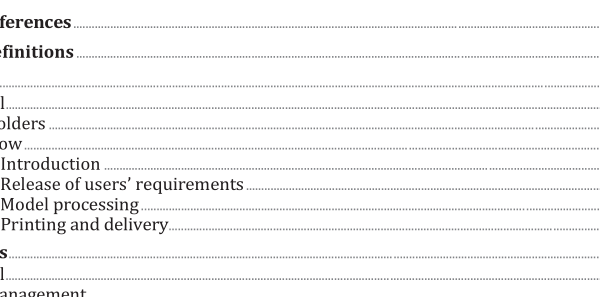ISO IEC 23510:2021 pdf download – Information technology — 3D printing and scanning — Framework for an Additive Manufacturing Service Platform (AMSP).
1 Scope This document specifies the framework for an Additive Manufacturing Service Platform (AMSP). The following elements are within the scope of this document: — Overview introducing the stakeholders and workflow of an AMSP. — Requirements specifying various prerequisite conditions from different aspects. — Framework defining a general functional architecture based on the identified requirements. — Use cases showing typical work modes of an AMSP. This document is applicable when individuals or organizations (e.g. commercial enterprises, government agencies and non-profit organizations) build an AMSP or improve existing ones to provide 3D printing and other services specific to the submission, design and creation of AM parts. 2 Normative references The following documents are referred to in the text in such a way that some or all of their content constitutes requirements of this document. For dated references, only the edition cited applies. For undated references, the latest edition of the referenced document (including any amendments) applies. ISO/ASTM 52900, Additive Manufacturing — General Principles — Fundamentals and vocabulary ISO/ASTM 52901, Additive manufacturing — General principles — Requirements for purchased AM parts 3 Terms and definitions For the purposes of this document, the terms and definitions given in ISO/ASTM 52900 and the following apply. ISO and IEC maintain terminology databases for use in standardization at the following addresses: — ISO Online browsing platform: available at https://www.iso .org/obp — IEC Electropedia: available at https://www.electropedia .org/ 3.1 additive manufacturing service platform AMSP platform that uses additive manufacturing technology and information technology to provide services according to users ’ requirements Note 1 to entry: Examples of services provided include objects/parts manufactured by AM technology, 3D model designs and other services specific to the submission, design and creation of AM parts. Note 2 to entry: A typical AMSP usually consists of an online platform to gather requirements of users, a group of skilled staff to deal with users ’ requirements, 3D scanning equipment, AM machines and different kinds of feedstock.
4.3.2 Release of users’ requirements Users are intended to be able to release their requirements on an AMSP in the following ways: — by creating 3D models using accessible design software provided on the platform, — by finding designers on an AMSP to help them achieve their ideas, — by using 3D scanning technology to generate 3D models, or — by selecting 3D models directly on an AMSP when there are already models that meet the users ’ requirements in the database. Sometimes, after the release of users ’ requirements, designers will receive commissions distributed by an AMSP. Designers can communicate with the users to improve their ideas and modify the 3D models. More importantly, they can ensure that 3D models are suitable for printing. When the 3D models are created, users can select colours, materials, lattices, textures, etc. according to their requirements. 4.3.3 Model processing After receiving the users ’ requirements, an AMSP can finish several necessary model processing steps, such as model error detection and correction, slicing, data protection, etc. The AMSP then generates a corresponding technical data package and distributes the printing task to the AM centres. Sometimes, model correction can be carried out by various automated, semi-automated and manual techniques. Technical data packages can be large, and data compression may be necessary. Data compression should conform with, but is not limited to, ISO/IEC 21320-1. Data compression occurs prior to encryption, otherwise compression is not possible due to the pseudo-random nature of encryption results. In addition, it is recommended to limit the range of encryption to only sensitive or confidential portions of the data such as those requiring intellectual property protection. Excluding model metadata from encryption allows easier reference and access to that metadata and eliminates unnecessary decryption. Note that methodologies of encryption and decryption are out of scope of this document.
ISO IEC 23510:2021 pdf download – Information technology — 3D printing and scanning — Framework for an Additive Manufacturing Service Platform (AMSP)






